

Blending technology and classroom learning: Jessie Woolley-Wilson at TEDxRainier. Blended learning and the future of education: Monique Markoff at TEDxIthacaCollege. Blended Learning Strategies. 5 Tips to Prepare for Blended Learning. First Person: Taking Learning out of the classroom. Homework from Geography teacher Mr Kelwin Koh can be anything from watching a video to hunting around your neighbourhood for rainforest leaves.
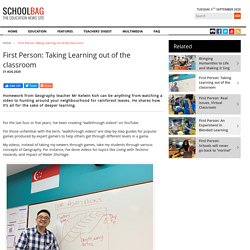
He shares how it’s all for the sake of deeper learning. For the last four or five years, I’ve been creating “walkthrough videos” on YouTube. For those unfamiliar with the term, “walkthrough videos” are step-by-step guides for popular games produced by expert gamers to help others get through different levels in a game. My videos, instead of taking my viewers through games, take my students through various concepts of Geography. For instance, I’ve done videos for topics like Living with Tectonic Hazards, and Impact of Water Shortage.
Taking the cue from the students The idea of walk-through videos actually came from my students when they asked me to make one for a particularly challenging topic. (21) Re-inventing Education for the Digital Age. The Case for Divergent Thinking. 3 Ways to Implement Blended Learning In The Classroom. By Rachelle Dene Poth Best practices for blending or flipping your classroom are hot topics of discussion in education today.
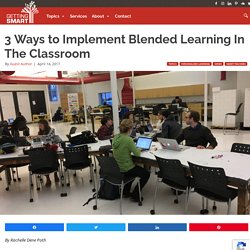
Much of the discussion focuses on finding clear definitions of what these terms mean and the benefit to classrooms. There are many resources and ways to educate yourself on this topic available including a diverse selection of books and blogs (such as the book Blended by Michael B. Horn and Heather Staker, and of course the Getting Smart blog) related to the topic, reaching out to colleagues or members of your PLN or attending conferences such as FETC, ISTE, state edtech conferences, edcamps and other professional development experiences. Blended Learning in the Classroom: Five creative ways to use it - CAE. The growth of eLearning isn’t just about online courses.
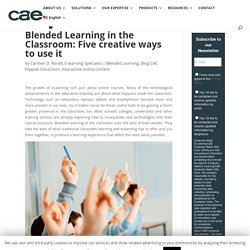
Many of the technological advancements in the education industry are about what happens inside the classroom. Technology such as computers, laptops, tablets and smartphones become more and more present in our lives. So, it makes sense for these useful tools to be gaining a much greater presence in the classroom, too. Most schools, colleges, universities and other training centres are already exploring how to incorporate new technologies into their course structure. Blended learning in the classroom uses the best of both worlds. 4 Tips for Managing Blended Learning With Google Classroom. With millions of teacher and student users around the world, Google Classroom has become a staple for work, collaboration, and learning.
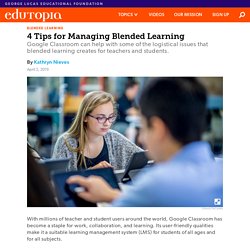
Its user-friendly qualities make it a suitable learning management system (LMS) for students of all ages and for all subjects. As more and more schools try blended learning, many teachers may wonder: How can I use Google Classroom as a learning management system for blended learning experiences? In my classroom, my students rotate through a station rotation blended learning model. Each station is a different task, one of which is working in a small group with me. The technology station is an asynchronous course to support students in building reading and grammar skills—asynchronous meaning that students are free to work through the content at their own pace. The following recommendations are ways teachers can seamlessly integrate asynchronous blended learning elements into their coursework while using Google Classroom as an LMS. 1. 2. 3. 4. Centre for Teaching Excellence.
Blended learning: the new normal and emerging technologies. Adams Becker, S., Cummins, M., Davis, A., Freeman, A., Hall Giesinger, C., & Ananthanarayanan, V. (2017).

NMC horizon report: 2017 higher Education Edition. Austin: The New Media Consortium. Google Scholar Alhabeeb, A. M. (2015). The quality assessment of the services offered to the students of the College of Education at King Saud University using (SERVQUAL) method. Adams Becker, S., Cummins, M., Davis, A., Freeman, A., Hall Giesinger, C., & Ananthanarayanan, V. (2017).
Blended Learning - What is it and how is it used? If you’re familiar with eLearning in any way, there’s no doubt you’ll have heard about blended learning.
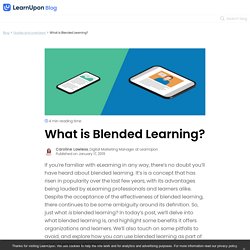
It’s is a concept that has risen in popularity over the last few years, with its advantages being lauded by eLearning professionals and learners alike. Despite the acceptance of the effectiveness of blended learning, there continues to be some ambiguity around its definition. Blended Learning: Where Tradition Meets Technology. Ever since the World Wide Web started making inroads into our homes and schools, researchers and practitioners have been exploring ways to combine both traditional and new ways of teaching.
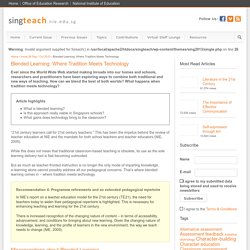
How can we blend the best of both worlds? What happens when tradition meets technology? Article highlights. 12 Different Types of Blended Learning. By TeachThought Staff Blended Learning is not so much an innovation as it is a natural by-product of the digital domain creeping into physical spaces.
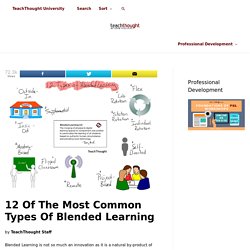
Broadly speaking, blended learning just means a mix of learning online and face-to-face, which means it’s likely your students are already doing some form of blended learning and have for years. As digital and social media become more and more prevalent in the life of learners, it was only a matter of time before learning became ‘blended’ by necessity. Blended learning and the future of education: Monique Markoff at TEDxIthacaCollege. BLENDED LEARNING.